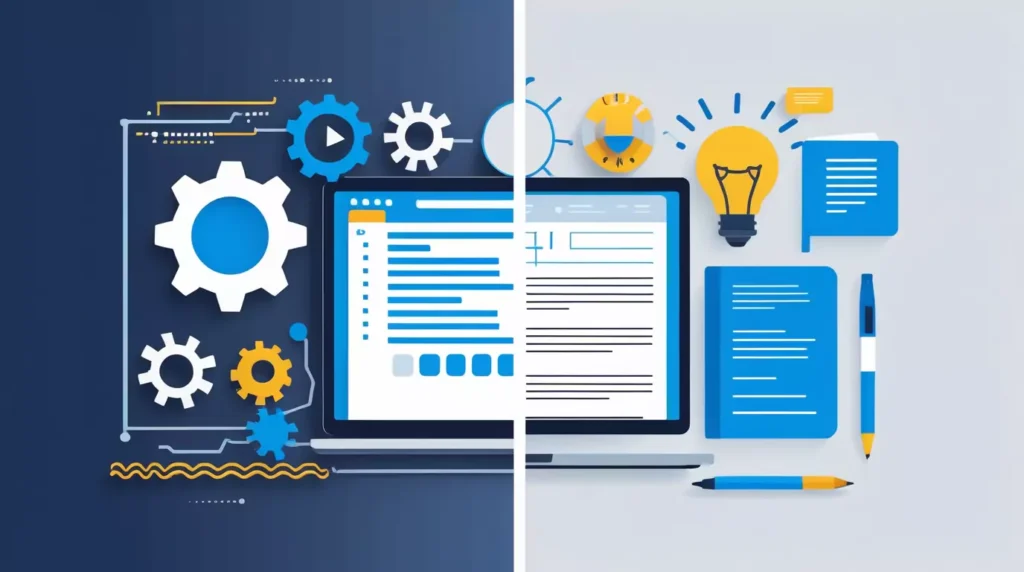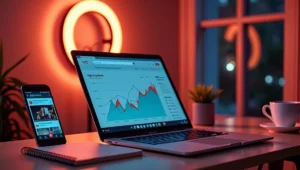Technical SEO vs Content SEO
When you hear the word SEO, you may think it’s all about writing good content. But there’s more to it! SEO has two important parts – Technical SEO and Content SEO.
- Technical SEO vs Content SEO
- What is Technical SEO?
- 1. Website Speed
- 2. Mobile-Friendliness
- 3. Crawlability & Indexation
- 4. SSL (HTTPS)
- 💖 You Might Also Like
- 5. XML Sitemap & Robots.txt
- 6. Structured Data (Schema Markup)
- 7. Fixing Errors
- 🔍 Why it Matters
- What is Content SEO?
- 1. Keyword Research
- 2. Content Quality
- 3. Headings and Structure
- 4. Meta Titles & Meta Descriptions
- 5. Internal Linking
- 6. Using Images & Videos
- 7. Content Freshness
- 🔍 Why it Matters
- 🟦 Technical SEO vs Content SEO: Key Differences
- ✨ More Stories for You
- Simple Explanation
- Which One Should You Focus On First?
- 🔧 If Your Website is New or Has Technical Issues → Start with Technical SEO
- 🖋️ If Your Website is Technically Sound → Focus on Content SEO
- ⚖️ Best Strategy? Balance Both!
- How Technical SEO and Content SEO Work Together
- 🌟 Don’t Miss These Posts
- 🤝 Example 1: Internal Linking + Crawlability
- ⚡ Example 2: Page Speed + Content Engagement
- 📱 Example 3: Mobile Optimization + Readability
- Why It Matters
- 📌 Quick Checklist: How They Work Together
- Common SEO Mistakes to Avoid
- 1. Slow Website Speed
- 2. Missing or Broken Internal Links
- 3. Duplicate Content
- 4. Missing Meta Titles or Descriptions
- 5. Poor Mobile Experience
- 6. Google Can’t Index Your Pages
- 7. Writing Content Without Keyword Strategy
- 8. No SEO Audit or Content Gap Check
- ✅ Pro Tip: Use Tools Like:
- Final Thoughts: Combine Technical SEO and Content SEO for Real Results
- 💡 Quick Recap:
- 📣 Ready to Boost Your Rankings?
- Frequently Asked Questions
- Should I fix technical SEO issues before working on content SEO?
- How does technical SEO impact my content’s visibility on Google?
- Can I rank on Google with just content SEO and no technical SEO?
- How do I balance technical SEO and content SEO in my strategy?
- What’s the SEO benefit of combining structured data with optimized content?
- Is technical SEO more important for e-commerce sites than content SEO?
- What are the most common technical SEO issues that hurt content performance?
Many people ask, “What is the difference between Technical SEO and Content SEO?”
It’s simple:
- Technical SEO helps your website run fast, be easy to load, and allows Google to find your pages.
- Content SEO helps you write useful and interesting things that people want to read.
Both are very important. But here’s the thing – even if your content is amazing, it won’t show up on Google if your technical SEO is broken. That’s why technical SEO matters for content visibility.
In this blog, we’ll explain Technical SEO vs Content SEO in a simple way. We’ll also help you understand which one you should focus on first to get better Google rankings and more website visitors.
What is Technical SEO?
Technical SEO is all about making your website easy for search engines like Google to find, read, and understand.
Imagine your website is a house. Technical SEO is like building a strong foundation, installing proper wiring, and making sure the doors are open so Google can come in, look around, and decide if it should show your site to users.
Here’s what Technical SEO includes:
1. Website Speed
A slow site = bad experience. Google loves websites that load fast. Speed is one of the top ranking factors today.
2. Mobile-Friendliness
Your site must work well on phones and tablets. Google mostly checks the mobile version of your site to rank it.
3. Crawlability & Indexation
This means making sure search engines can find (crawl) and save (index) your web pages. If they can’t, your site won’t show in search results.
4. SSL (HTTPS)
A secure site (with a lock symbol 🔒) builds trust and helps SEO. Google prefers HTTPS over HTTP.
💖 You Might Also Like
5. XML Sitemap & Robots.txt
- The sitemap is like a map of all your pages – it helps Google find everything.
- The robots.txt file tells Google which pages to skip and which to read.
6. Structured Data (Schema Markup)
Structured data adds special code that helps Google understand your content better – like showing star ratings, product info, or FAQs directly in search.
7. Fixing Errors
Broken links, duplicate content, or missing pages hurt your SEO. A technical SEO checklist for content marketers ensures everything works smoothly.
🔍 Why it Matters
Even if your blog post or product page is amazing, Google won’t rank it if it can’t read it properly. That’s why technical SEO is the first step to get visibility.
What is Content SEO?
Content SEO is all about what you write on your website – and how you write it – so that both people and Google can understand it easily.
If technical SEO is like building a house, then content SEO is like decorating it with useful and interesting things that visitors love.
Good content helps your website rank higher, attract the right audience, and keep them engaged.
1. Keyword Research
Before writing, you find out what people are searching for. Then you use those keywords naturally in your content.
Example: Someone types “best running shoes for men” — if your article uses that phrase smartly, it can show up on Google.
2. Content Quality
Google wants content that’s helpful, original, and easy to read. So your writing should answer people’s questions clearly.
3. Headings and Structure
Using headings (H1, H2, H3) makes your content easy to read. It also helps Google understand what your page is about.
4. Meta Titles & Meta Descriptions
These are the short texts that show on Google search results. A good meta title helps people click your page.
Example:
Title: Best Laptops for Students in 2025
Description: Discover top-rated, budget-friendly laptops perfect for school, college, and online classes.
5. Internal Linking
Linking one page to another on your site helps users stay longer and helps Google crawl your site better.
6. Using Images & Videos
Adding images, videos, and charts makes your content more engaging. Just remember to optimize images with alt text.
7. Content Freshness
Updating your content with new information helps it stay relevant and rank better.
🔍 Why it Matters
Even if your website is fast and mobile-friendly, Google still needs great content to decide what to rank it for.
Without content SEO, your site might be invisible to people who are actually searching for your services or information.
🟦 Technical SEO vs Content SEO: Key Differences
Now that you know what Technical SEO and Content SEO mean, let’s look at how they’re different — and why you need both to grow your website.
✨ More Stories for You
Think of it like this:
🛠️ Technical SEO = Backend (How your site works)
✍️ Content SEO = Frontend (What your site says)
Here’s a simple side-by-side comparison:
| Feature | Technical SEO | Content SEO |
|---|---|---|
| Focus | Website structure & code | Words, blogs, pages, user experience |
| Purpose | Helps Google crawl & index your site | Helps Google rank your content |
| Example Tasks | Speed, mobile-friendliness, SSL | Keyword usage, headings, meta tags |
| Tools Used | Screaming Frog, GSC, Ahrefs (tech part) | SEMrush, SurferSEO, Grammarly |
| Skills Needed | Developer or SEO tech knowledge | Writing, marketing, keyword research |
| SEO Impact | Improves visibility in Google’s eyes | Improves relevance & traffic |
| Time to See Results | Faster site = quicker crawling | Good content = long-term rankings |
Simple Explanation
- Technical SEO helps Google understand your website.
- Content SEO helps Google understand what your pages are about.
You can’t rank without one or the other. It’s like a car with no engine (tech SEO) or a car with no fuel (content SEO) – both are needed to move forward.
Which One Should You Focus On First?
This is a common question:
👉 Should I focus on technical SEO or content SEO first?
The answer depends on your website’s current condition. But here’s a simple way to understand it:
🔧 If Your Website is New or Has Technical Issues → Start with Technical SEO
Before you write content, make sure your website is:
- Loading fast
- Mobile-friendly
- Crawlable by Google
- Free from errors (like broken links or duplicate pages)
📌 Why?
Because if your site has technical problems, Google might not even see or index your content — no matter how great it is.
✅ Example:
A blog post can’t rank if the page takes 10 seconds to load or isn’t mobile-friendly.
🖋️ If Your Website is Technically Sound → Focus on Content SEO
Once your technical setup is clean, start creating:
- Useful blog posts
- Product descriptions
- Service pages
- FAQs
- Keyword-optimized content
📌 Why?
Because content tells Google what your website is about, and helps people find you in search results.
✅ Example:
A perfectly coded website with no content is like a shop with no products – people will leave quickly.
⚖️ Best Strategy? Balance Both!
For long-term SEO success, don’t choose one over the other. Instead:
- Start with a technical SEO audit
- Fix the basics (speed, mobile, indexing)
- Then move on to content planning and optimization
This is how big websites grow – they combine strong tech foundations with valuable content.
| Situation | What to Focus On First |
|---|---|
| New Website | Technical SEO |
| Local business with slow site | Technical SEO |
| Blog with no traffic | Content SEO |
| E-commerce store with duplicate pages | Technical SEO |
| Clean site but no content | Content SEO |
| Both are weak | Start with tech, then content |
How Technical SEO and Content SEO Work Together
Now you know what technical SEO and content SEO are. But the real SEO magic happens when you combine both.
🌟 Don’t Miss These Posts
They’re not enemies – they’re teammates. And when they work together, your website performs better on Google and gives users a great experience.
🤝 Example 1: Internal Linking + Crawlability
You add internal links in your blog (that’s content SEO).
But if your sitemap is missing or Google can’t crawl those links (that’s technical SEO), they won’t help you rank.
✅ Together: Proper internal linking + working sitemap = better crawlability and page authority.
⚡ Example 2: Page Speed + Content Engagement
You write an amazing article (content SEO), but it takes 8 seconds to load.
Visitors leave before reading it – Google notices this and drops your rankings.
✅ Together: Fast-loading pages + useful content = happy users + higher rankings.
📱 Example 3: Mobile Optimization + Readability
You use perfect keywords and headings (content SEO), but your font is too small on mobile or buttons are hard to click.
✅ Together: Mobile-friendly design + easy-to-read content = better SEO and lower bounce rate.
Why It Matters
Google looks at both technical health and content quality when deciding where to rank your page.
If your site is hard to crawl, it won’t matter how great your content is.
If your site is technically perfect but has no value, it won’t rank either.
You need both.
📌 Quick Checklist: How They Work Together
| Task | Technical SEO | Content SEO |
|---|---|---|
| Load Speed | ✅ | |
| Keyword Targeting | ✅ | |
| Meta Tags | ✅ | ✅ |
| Internal Links | ✅ (structure) | ✅ (placement) |
| Sitemap & Robots.txt | ✅ | |
| Readable Headings | ✅ | |
| Structured Data | ✅ | ✅ |
Common SEO Mistakes to Avoid
Even if you’re doing your best, some small mistakes in technical SEO or content SEO can hurt your Google rankings.
Here are the most common SEO mistakes — and how to fix them.
1. Slow Website Speed
A website that takes more than 3 seconds to load is a problem.
People leave, and Google notices.
🔧 Fix it:
- Compress images
- Use caching
- Switch to a fast web host
- Minify CSS/JS files
2. Missing or Broken Internal Links
Internal links help users and Google explore your site.
If links are broken, users land on error pages — and that’s bad for SEO.
🔧 Fix it:
- Regularly check for broken links
- Use tools like Screaming Frog or Ahrefs to audit them
3. Duplicate Content
Copying the same content across multiple pages confuses Google — and hurts your ranking.
🔧 Fix it:
- Use original content
- Add canonical tags where needed
- Consolidate similar pages
4. Missing Meta Titles or Descriptions
These are what users see in search results.
If they’re missing or poorly written, people won’t click — even if you rank well.
🔧 Fix it:
- Write unique titles and descriptions for every page
- Use focus keywords naturally
- Make them click-worthy
5. Poor Mobile Experience
If your site looks bad or loads slowly on a phone, visitors will leave — fast.
🔧 Fix it:
- Use a mobile-responsive theme
- Test using Google’s Mobile-Friendly Test
- Improve font size, button spacing, and layout
6. Google Can’t Index Your Pages
Sometimes pages are blocked by mistake in robots.txt, or there’s a missing sitemap.
🔧 Fix it:
- Run a technical SEO audit
- Submit your sitemap to Google Search Console
- Fix crawl errors and indexing issues
7. Writing Content Without Keyword Strategy
Just writing isn’t enough.
If your content doesn’t target what people are searching for, it won’t rank.
🔧 Fix it:
- Do keyword research
- Use long-tail keywords
- Optimize headings, meta tags, and body content
8. No SEO Audit or Content Gap Check
If you’re not auditing your site regularly, you’re likely missing issues that affect ranking.
🔧 Fix it:
- Do a monthly technical audit vs content gap analysis
- Fix errors and update outdated content
- Track changes and improvements
✅ Pro Tip: Use Tools Like:
- Google Search Console (free)
- Screaming Frog (technical SEO audit)
- SurferSEO / Clearscope (content SEO check)
- Ahrefs / SEMrush (keyword & backlink analysis)
Final Thoughts: Combine Technical SEO and Content SEO for Real Results
If you’re serious about growing your website traffic, you can’t pick only one side of SEO.
Both technical SEO and content SEO are equally important — they work together like the engine and fuel of your website.
- One helps Google find and crawl your pages.
- The other helps Google rank and recommend your content to real people.
👉 Start with a strong technical base, then build high-quality, keyword-rich content on top of it.
💡 Quick Recap:
- Fix speed, mobile issues, and indexing problems (Technical SEO)
- Write valuable, optimized, and user-friendly content (Content SEO)
- Keep checking and improving both regularly
📣 Ready to Boost Your Rankings?
Whether you’re a blogger, business owner, or agency — your website needs both smart content and solid structure to win on Google.
✅ Need help with a technical audit or content strategy?
Let’s work together to fix what’s holding your site back and create content that actually ranks.
Frequently Asked Questions
Should I fix technical SEO issues before working on content SEO?
Yes, it’s recommended to fix major technical SEO issues like crawl errors, slow loading, or indexing problems first. Without a strong technical foundation, your content won’t rank even if it’s optimized.
How does technical SEO impact my content’s visibility on Google?
Technical SEO ensures that Google can crawl, index, and understand your content. If your website has poor structure, slow speed, or mobile issues, it can prevent even well-written content from showing up in search results.
Can I rank on Google with just content SEO and no technical SEO?
You might rank temporarily, but without technical SEO, your content could face crawling issues, low loading speed, or mobile usability problems – all of which hurt long-term rankings and user experience.
How do I balance technical SEO and content SEO in my strategy?
Start with a technical SEO audit to fix crawl, speed, and mobile issues. Then create a content plan based on keyword research and user intent. Review both monthly to ensure balance and ongoing improvements.
What’s the SEO benefit of combining structured data with optimized content?
Structured data (technical SEO) helps Google better understand your content and display rich results (like FAQs, ratings, etc.), while optimized content increases relevance. Together, they boost visibility and CTR in search results.
Is technical SEO more important for e-commerce sites than content SEO?
Yes – for e-commerce sites, technical SEO is often more critical because of large product databases, filters, and crawl budget issues. However, content SEO still plays a key role in category pages, product descriptions, and blog content.
What are the most common technical SEO issues that hurt content performance?
The most common issues include broken internal links, missing sitemaps, blocked pages in robots.txt, slow page speed, mobile errors, and missing structured data. These can stop your content from ranking, even if it’s well-optimized.














